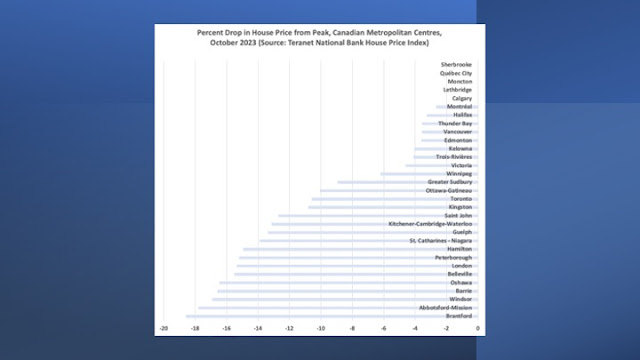The latest house price figures have been released by the Teranet-National Bank House Price Index for major Canadian metropolitan centres in Alberta, British Columbia, New Brunswick, Manitoba, Nova Scotia, Ontario, and Quebec. According to Teranet:
After adjusting for seasonal effects, the Teranet-National Bank Composite House Price Index™, which covers the country’s eleven largest CMAs, declined by 0.4% from September to October, the first decrease following five consecutive monthly increases. In October, four of the 11 CMAs included in the index experienced decreases: Toronto (-1.6%), Edmonton (-1.2%), Vancouver (-1.1%) and Ottawa-Gatineau (-1.1%). Conversely, notable increases were recorded in Montreal (+3.7%), Halifax (+1.1%) and Winnipeg (+1.0%). On the other hand, decreases were observed in 11 of the 20 CMAs not included in the composite index for which data are available in October. The biggest monthly decreases were seen in Saint John (-5.3%), Trois-Rivières (-3.3%) and London (-2.5%). Conversely, the biggest increases were in Moncton (+4.6% after a 2.3% drop the previous month), Kingston (+3.8%) and Peterborough (+2.6%).
The month over month figures for October show decline in most centres but the more interesting numbers are the declines from the peak price. Peak price for most of these cities occurred in Spring of 2022 though Calgary and Saint John appear to have seen peaks in 2023. The accompanying figure shows that no one has seen a price increase since the peak though Sherebrooke, Quebec City, Moncton, Lethbridge, and Calgary appear to be perfectly flat since their peak.
As for the remaining cities, the percent change since peak price range from -2.7 percent for Montreal to -18.6 percent for Brantford. Thunder Bay is in the company of cities with relatively small declines coming in at -3.6 percent while Sudbury is a bit more coming in at -9 percent.
